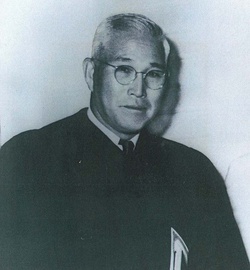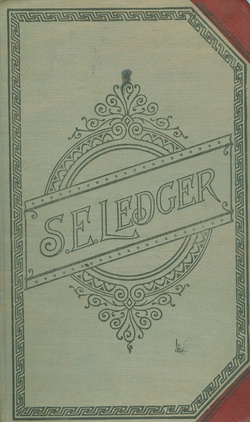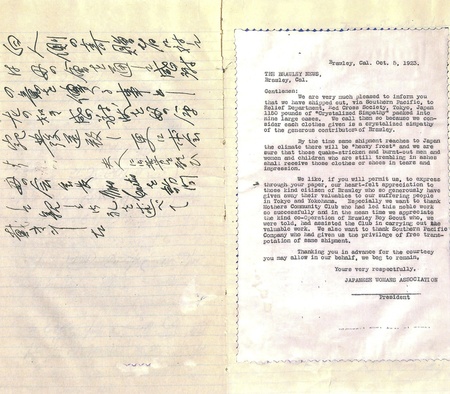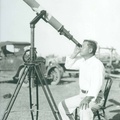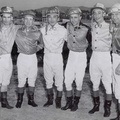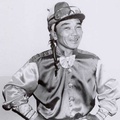In early February 2014, just as The Rafu Shimpo was beginning to mark the third anniversary of the March 11 earthquake and tsunami that struck northeastern Japan and extol the continued relief efforts of the Nikkei community in the United States, Randy Sakamoto, the historian of the West Los Angeles United Methodist Church (WLAUMC), was scanning old church documents. Among the boxes and files in his charge, he uncovered a ledger book dated 1923. The contents were written almost entirely in Japanese, but a place name written in English under several of the entries throughout the ledger immediately caught his eye. It was Brawley. Randy stated that the timing was “by very great coincidence,” because just two days earlier, on February 10, 2014, he was in Brawley for the first time as part of a WLAUMC Tanoshimi-Kai bus tour. The theme of the trip was “Tracing the History of Japanese Americans in Imperial Valley.” Before reaching its primary destination—the Japanese American Gallery in the Pioneers Museum—the tour group was led to a vacant lot in Brawley on the corner of 7th and C Streets. It was the pre-World War II location of the Japanese Methodist Episcopal Church. Established in 1913, it was the first Nikkei Church in the Imperial Valley.
The ledger had come from the Japanese Methodist Episcopal Church, and its contents document the relief efforts of Imperial Valley Issei women for the victims of the Great Kanto Earthquake. Presumably, the accounting book arrived at the WLAUMC with Reverend Susumu Kuwano who was the last pastor of the Brawley church, serving in that capacity from 1933 until the outbreak of the Second World War. Rev. Kuwano became the minister of the WLAUMC when its doors were reopened in late 1945. According to Randy, he was chosen to “guide the recovery of the church” after the war.
On September 1, 1923, the Great Kanto Earthquake devastated Tokyo, Yokohama, and the surrounding area. The magnitude 7.9 earthquake and resulting firestorm caused nearly 143,000 fatalities and destroyed approximately 694,000 homes. By comparison, the March 11, 2011, Tohoku (Northeastern) earthquake was registered at a magnitude of 9.0. Hardest hit were the prefectures of Miyagi, Fukushima, and Iwate. The earthquake and consequent tsunami and Fukushima nuclear disaster caused 15,887 deaths and displaced 131,000 persons.
The desire to help the victims exhibited by an extraordinary number of Nikkei organizations such as the Japanese Cultural and Community Center of Northern California, which created the Northern Japan Earthquake Relief Fund; businesses such as Tanaka Farms in Orange County with its annual “Walk the Farm” benefit; and individuals, such as Dr. Paul Terasaki, who sponsored college students to go to the Tohoku region; was quick and significant. However, it was not unprecedented. In his article “Grateful Crane Ensemble’s Goodwill Tour to Tohoku” in the June 16, 2014, issue of The Rafu Shimpo, Grateful Crane executive producer Soji Kashiwagi shared what he said to the survivors prior to each of his group’s performances: “We saw in you what had been taught to us. When help is needed we help each other. So in the spirit of our parents and grandparents, we are here to carry on our tradition of otagaisama [to help each other in times of need].” As an example, Kashiwagi cited how even though Japanese American families were struggling to get back on their feet during the post-World War II resettlement period, they nonetheless sent care packages to relatives in war-torn Japan.
An even earlier precedent for otagaisama was set by the Issei women in the Imperial Valley who were so moved by news of the plight of the victims of the Great Kanto Earthquake that they felt compelled to take action. A clothing drive was spearheaded by the Brawley Japanese Methodist Episcopal Church Funjinkai (Women’s Auxiliary) in coordination with other fujinkai in El Centro, Heber, and Calexico. The fujinkai’s appeal for support was an emotional one: “Thousands in our motherland (母国) suffer in misery. Men, women, and children remain homeless amidst ashes as winter approaches. We hear their cries.”
The Mother’s Community Club of Brawley (a non-ethnic Japanese group) also contributed to the clothing drive with the Brawley Boy Scouts assisting the club with the legwork. A sample of one donation made by Mrs. G. Ihara included a men’s coat, a lady’s overcoat, two pairs of pants, three dresses, a sweater, skirt, two vests, seven pairs of underclothes, two men’s shirts, and three pairs of shoes. All told, 1,150 pounds of clothing was consolidated at the Japanese Association hall in Brawley. Destined for the Red Cross Society’s Relief Department in Tokyo, the goods had to be shipped by rail out of the Imperial Valley to Los Angeles. The freight was provided gratis by the Southern Pacific Company. What is remarkable is that the Issei ladies were able to mobilize and successfully accomplished that endeavor when they themselves could have benefitted from such aid. The post-World War I agricultural depression caused economic despair in farming communities throughout the 1920s. The Imperial Valley’s ethnic Japanese cotton growers and dairymen, in particular, fell on hard times.
The ledger is a complete archive of the relief efforts. It includes a handwritten report; an informational bulletin about the relief drive issued in the name of the fujinkai of Brawley, El Centro, Heber, and Calexico; a clipping of an announcement about the drive that appeared in a Japanese-language newspaper; a press release typed in English sent to the Brawley News from the Brawley fujinkai; the bill of lading for the goods shipped via the Southern Pacific railroad; a donor list of seventy-nine ladies* with their contributions itemized; an inventory of goods donated collectively by the Mother’s Community Club; clippings of articles about the drive that subsequently appeared in the Brawley News on September 27, 1923, and The Rafu Shimpo on October 5, 1923; a record of monetary donations; and itemized expenses and receipts for supplies purchased. The text is not only written in “old kanji” (kyūjitai), but also in a highly cursive style. Although any future translation is by no means impossible, it would be a formidable task.
On March 7, 2014, the WLAUMC board of trustees approved the transfer of ownership of the ledger to the Japanese American Gallery of the Pioneers Museum in Imperial. Thanks to the love and faith of the West Los Angeles United Methodist Church, and a serendipitous discovery, a valuable artifact has been added to the Japanese American Gallery Collection. As church historian Randy Sakamoto put it, “WLAUMC is very happy that the Brawley Ledger has returned home. Both at the proper place and into the right hands.”
*The Donors
In some cases both the women’s surname and given name (in that order) were recorded in the ledger, while in other cases the ladies are listed as “the wife of …” The latter cases are rendered below simply as “Mrs. ___,” as in 19. Mrs. Kimura for the ledger entry 19. Kimura Ichimatsu fujin. Because of the obscure reading of some Japanese surnames and the cursive handwriting, not all names could be translated. When known, the variant spelling of a surname adopted by an individual family (rather than the standardized Romanization) is provided below, as in Eddow for Edo or Takahash for Takahashi.
Names are numbered as they appear in the ledger:
1. Mrs. Tokuda
2. Mrs. Honda
3. Mrs. Kawasaki
4. Aoyama Takako
5. Taira Tsuruko
6. Sase Takeko
7. Mrs. Sano
8. Mrs. Kunihiro
9. Mrs. Sonoda
10. Okitsu Miyoko
11. Mrs. Miyagi
12. Kikuchi Mitsuko
13. Anonymous
14. Nakahama Fumiyo
15. Mrs. Fujimoto
16. Tokeshi Kame
17. Tsumura Shinayo
18. Sugiyama Kanoko
19. Mrs. Kimura
20. unreadable
21. Mrs. Rosa Hudlin
22. Mrs. G. T. Ihara
23. Fujita Kanko
24. Mrs. Uchida
25. Mrs. Kitamura
26. Sugimura Suwa
27. Mrs. Ohtsuka
28. Asamen Eda
29. Hosokawa Miharu
30. Mrs. Burger
31. Mrs. Sakakibara
32. Mrs. Nakamura
33. Mrs. Nagato
34. Mrs. Sugino
35. unreadable
36. Mrs. Toyama
37. Mrs. Shimamoto
38. Kobayashi Umeko
39. Mrs. Myose
40. Uehara Toshiko
41. Kinjo Miyoko
42. Mrs. Kobashigawa
43. Fujinami Kichiko
44. Mrs. Scheniman
45. Mrs. Shiba
46. Mrs. Endou
47. Mrs. Fujimoto
48. Mrs. Mori
49. Mrs. Mori
50. Nishimoto Seiko
51. Mrs. Kouno
52. Mrs. Tanaka
53. Mineta Takiko
54. Ohkuma Senko
55. Mrs. Takagi
56. Mrs. Oda
57. Mrs. Akiyama
58. Mrs. Thomas Anderson
59. Niizato Tama
60. Mrs. Hayword
61. Anonymous
62. Sato Haruko
63. Mrs. Hoshimiya
64. Mrs. Tokeshi
65. Mrs. Kaniye
66. Mrs. Ralph Anderson
67. Mrs. Arima
68. Mrs. Akiyama
69. Mrs. Hamachi
70. Mrs. Sahara
71. Mrs. Takahashi
72. Mrs. Shigemura
73. unreadable
74. Mrs. Shinkawa
75. Eddow Mikiko
76. Mrs. Tamaru
77. Takahash Setsu
78. Mrs. Saito
79. Yasutaka Kichiko
*This article was originially published in the Teikoku Heigen News: Newsletter of the Japanese American Gallery (Winter 2015, Number 29).
© 2015 Tim Asamen


